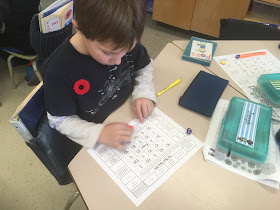This little guy has been a big helper this week in our classroom.
Good readers can use chunks or small words inside big words to figure out unknown words. By chunking a word, you can use the parts you do know to help you figure out the parts you do not know. Chunky Monkey allows you to break down the word into chunks or word parts that you already know. You can use your knowledge of word families to help read harder words!
You might like to watch the following video that explains how this strategy was introduced to your child in his or her early reading work last year. This USA teacher does a great job and has focused on clear explanations to parents.
Click here
Now that your child is reading much longer stories, much longer words are being encountered. Some are feeling confident and really trying to figure out those words. Others are just overwhelmed because the words are 6, 7 or 8 letters long (and longer)!
It was time for them to revisit an old strategy and make it work for longer words, so Chunky Monkey is back! (Research shows that better readers chunk rather than sound out. This is because words like
/enough/ or /thumb/ or /because/ are not really words that sound like they are written. By recognizing the chunks, the reader is more successful, especially when used with our other decoding strategies).
What are chunks? Sometimes, they are the parts of the words that we called 'syllables'.
We worked this week on using first our finger and then our pencil to see the 2 or 3 letters that include a vowel that we could read. Above are some examples that we explored. It is ABSOLUTELY not important that the students know the 6 types of syllables.
The examples above were used to show that sometimes the students would find a consonant on both sides of the vowel and sometimes there would only be a consonant on one side of the vowel.
Here are some pictures of the students working together to 'chunk' the larger words into smaller parts. They were so proud of how many of the words they could do on their own.

I don't have a clue why these next few photos show up in this way...upside down.
Tried a few fixes but we'll just go with this.
The students have been really working hard on recognizing two digit numbers in a variety of forms. In this activity, they had to choose a two digit number, which they hid under the little blue dot. They drew at least one way to represent the number, they were to write 3 clues so that their classmates could guess the mystery number.
I'll help you read this one:
It is an odd number. The equation would say 40+41. This is a two digit number.
Did you guess 81???!!!
I had a question about the 'new math' that the students are doing and how the new curriculum that will be introduced in the next few years will affect this.
First of all, there is no 'new' math. Numbers are numbers. They add up to only one correct answer (most of the time)
What has changed is the manner in which we encourage the students to 'play' with the numbers, understand their relationship, learn how to manipulate them, and basically, believe that working with numbers is both easy and fun.
When I taught students to add 2 digit numbers 'back in the day', there was only one way for everyone to do it. Pity the poor student who couldn't figure out what I was talking about....they just got more math sheets to practise on.
Now, I make sure that the students really understand what is happening when two digit numbers are being added together. If they add the tens before the ones, that's okay. If they say 'I will add 30, then take 2 away' when they are asked to add 28 to another number, that's okay. If they need manipulatives to assist them in getting to the answer, that's okay too. Once they feel that they have 'discovered' what addition is about, then I will introduce the algorithm (the way that most North Americans add) and explain that it is important to have an efficient way to get to the answer. By then, they are confident is what the addition of two digit numbers is about, and are ready to try the recognized method that their parents are using.
Just by the by, in different countries students are taught algorithms that you and I would find confusing and very different than what you learned and use today. Our way is not the only way. Keep an open mind about something different than your way being used.
In the end, if your child is confident and correct, that's what the end goal is all about!
If your child can play with numbers, they will be more successful when algebra is introduced in Jr. High....trust me!









No comments:
Post a Comment